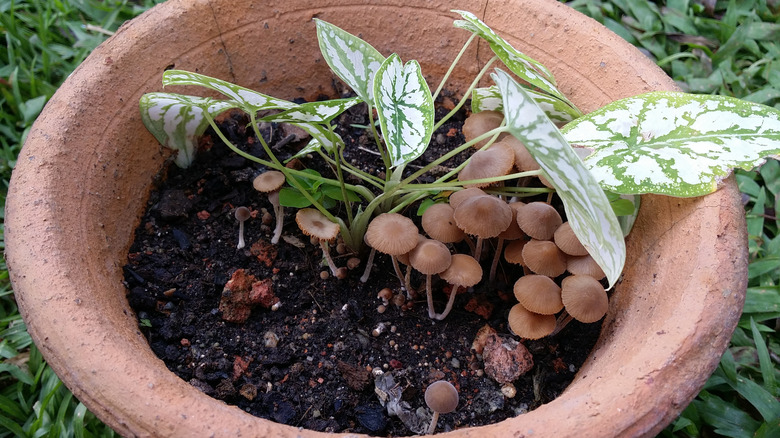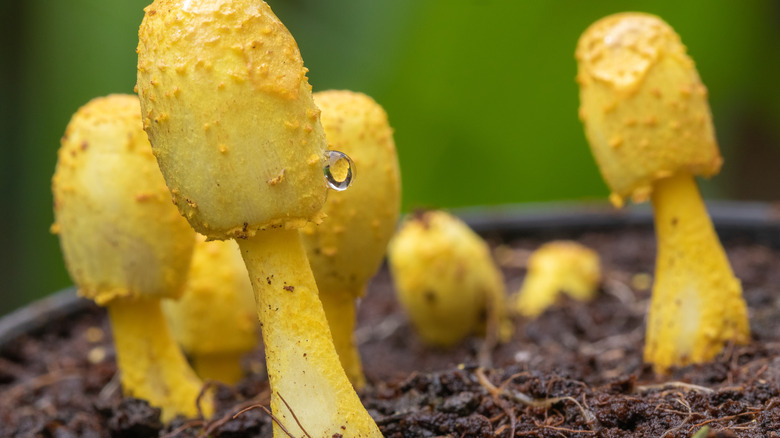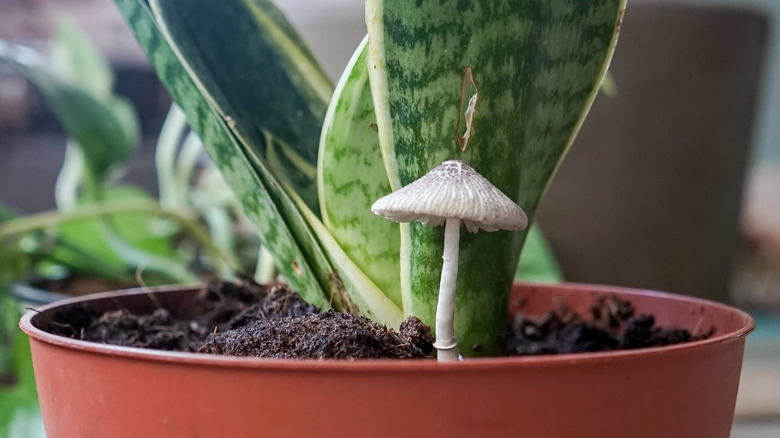What It Means If Mushrooms Are Growing In Your Houseplants
Finding a mushroom growing in your houseplant can be a shocking sight. Your immediate reaction might be to assume there's something wrong with your plant or that it's developed some sort of disease, but that is certainly not the case. Not only is finding a mushroom in the pot not a cause for concern, but it can actually be a positive indication of your plant's growth.
According to Two Peas in a Condo, the mushrooms that grow in houseplants are typically leucocoprinus birnbaum, which is also called Plantpot Dapperling, due to how common they are in potted vegetation. This mushroom starts off small and yellow and develops into a balloon-shaped fungus.
There are a few reasons that mushrooms could be growing in your houseplants. One of the most common is simply that spores somehow got introduced to the soil. This can happen in a few ways, though the most common is that there were mushroom spores in the air near your houseplant, likely at a garden center. Bags of soil can also host mushroom spores that can grow in the pot.
Are mushrooms in your houseplants harmful?
While simple spore cross-contamination is the most common cause of mushroom growth in your houseplants, there are a few more potential causes. Although any soil can be exposed to mushroom spores, super-rich and moist mixes are more likely to help the spores grow. Mushrooms can also signify an over-watered plant, though Planet Houseplant notes that, in this case, it would likely grow mold before a mushroom.
Finding a mushroom in your houseplant is far from a death sentence. If the fungus is the common Plantpot Dapperling, it will only feed off of decaying matter (like gnats and other pests) and not your plant's roots or soil. However, mushrooms can be a sign of possible root rot, so if it displays it or other diseases, consider repotting your plant.
Don't confuse mushroom growth with common houseplant fungal infections, though. If you notice fungal leaf spots or powdery mildew on your plants, like that noted in Smart Garden Guide, act immediately in treating the infection.
How to get rid of mushrooms in your houseplants
While you can certainly try to get rid of mushrooms in your houseplants, it may be a futile cause. The easiest way to get rid of them is by simply removing them at the base, but since they self-germinate through tons of spores, they're very likely to grow back. While they are toxic to humans, it shouldn't be an issue if it's just you. However, if there are children or pets in the house, though, it's a good idea to do your best to get rid of the fungus.
To fully eliminate mushrooms in your houseplants, you'll need to repot your plant (per Planet House Plant). In fact, it's a good idea to repot all nearby plants that may have spores in their soil. Make sure you very thoroughly wash your pot with hot and soapy water. You can use fungicides, but they may do more harm than good. Some plants may even benefit from the presence of leucocoprinus birnbaums, so don't go overboard trying to totally eliminate it.
If you want to avoid mushroom growth in the future, try and reduce humidity and moisture levels not only in your plant but in the room they're in (unless it would be detrimental to the plant's health to do so). Also, try removing any debris like dead leaves or mulch that the mushrooms could feed off.


